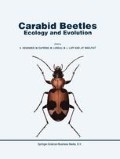Summary
Hedgerows interconnected in a network and connected to woods characterize the “bocage”, rural landscapes of western France.
Local populations of forest carabid species are present in hedgerows even far from a source forest. If exchanges of individuals occur between these populations, this would indicate a control at the landscape level, characteristic of the meta-population dynamics. By mark-recapture experiments, we have shown that local populations settle in nodes of the hedgerow network, either small woods or intersections of lanes bordered by parallel hedgerows. We tested the existence of dispersers using hedgerows as corridor by using the same mark-recapture technique all along hedgerows connecting two woods. Preliminary results indicate that individuals living in hedgerows are at low density and show a high intensity of movement compared to individuals living in woods or nodes of the network. Some woods are occupied and some are vacant. We propose a hypothetical representation of population dynamics of forest carabid beetles in the “bocage”.
Access this chapter
Tax calculation will be finalised at checkout
Purchases are for personal use only
Preview
Unable to display preview. Download preview PDF.
References
Baars, M.A. (1979) Patterns of movement of radioactive beetles. Oecologia, 41, 25–46
Boorman, S. and Levitt, P. (1973) Group selection on the boundary of a stable population. Theorical Population Biology 4, 86–128.
Burel, F. (1988) Biological patterns and structural patterns in agricultural landscapes. Connectivity in Landscape Ecology (ed K.F. Schreiber), Proc. 2nd IALE Seminar. Munstersche Geographische Arbeiten, 29, 107–110.
Burel, F. (1989) Landscape structure effects on Carabids beetles spatial patterns in western France. Landscape Ecology, 2, 215–226.
Burel, F. (1991) Dynamique d’un paysage, réseau et flux biologiques. Thèse d’état. Université de Rennes.
Den Boer, P.J. (1985) Fluctuations of density and survival of carabid populations. Oecologia, 67, 322–330.
Den Boer, P.J. (1990) The survival value of dispersal in terrestrial arthropods. Biological Conservation, 54, 175–192.
Deveaux, D. (1976) Influence des haies sur la répartition spatio-temporelle et la diversité des peuplements de Cara-biques en zone bocagère de l’Ouest. Les bocages: Histoire, écologie, économie, pp. 377–384. INRA, CNRS, ENSA et Université de Rennes.
Drach, A. (1980) Contributions à l’étude de l’écologie des Coléoptères Carabiques forestiers. Thèse de 3ème cycle. Université de Paris VII.
Drach, A. and Cancela da Fonseca, J.P. (1990) Approche expérimentale des déplacements de Carabiques forestiers. Revue d’Ecologie et de Biologie du Sol, 27, 61–71.
Fahrig, L. and Merriam, G. (1985) Habitat patch connectivity and population survival. Ecology, 66, 1762–1768.
Greenslade, P. (1965) On the ecology of some british carabid beetles with special reference to life history. Transactions of the Society for British Entomology 16, 149–179
Hastings, A. and Wolin, C.L. (1989) Within patch dynamics in a metapopulation. Ecology, 70, 1261–1266.
Henein, K. and Merriam, G. (990. The elements of connectivity where corridor quality is variable. Landscape Ecology, 4, 157–171.
Hobbs (1992) The role of corridors in conservation: solution or bandwagon. Trends in Ecology and Evolution, 7, 389–392
Jolly, G.M. (1965) Explicit estimates from capture-recapture data with both death and immigration — stochastic model. Biometrika, 52, 225–247.
Levins, R. (1970) Extinction. Some Mathematical Questions in Biology, pp. 75–108. Lecture on mathematics in life science. Vol. 2, American Society.
Loreau, M. (1983) Le régime alimentaire de Abax ater. Acta Oecologica, Oecologica generalis, 4, 253–263.
Meentemeyer, V. and Box, E.O. (1987) Scale effects in landscape studies. Landscape heterogeneity and disturbance (ed M.G. Turner), pp. 15–34. Ecological studies 64, Spinger Verlag, New York.
Murdoch, W.W. (1963) A method for marking Carabidae (Coleoptera). Entomologists’ Monthly, 94, 126–155.
Murphy, D.D., Freas, K.E. and Weiss, S.B. (1990) An environment-metapopulation approach to population viability analysis for a threatened invertebrate. Conservation Biology, 4, 41–51.
Merriam, G. and Lanoue, A. (1990) Corridor use by small mammals: field measurement for three types of Peromyscus leucopus. Landscape Ecology, 4, 123–133.
Pollard, E. (1968) A comparison between the Carabidae of a hedge and field site and those of a woodland glade. Journal of Applied Ecology, 5, 649–657.
Rijnsdorp, A.D. (1980) Pattern of movement in and dispersal from a dutch forest of Carabus problematicus Hbst. Oecologia, 45, 274–281.
Turin, H., Haeck, J. and Hengeveld, R. (1977) Atlas of the Carabid beetles of the Netherlands. Verhandelingen Afdeling Naturkunde, 68, 1–228.
Van Dorp, D. and Opdam, P. (1987) Effects of patch size, isolation and regional abondance on forest bird communities. Landscape Ecology, 1, 59–73.
Verboom, J. and van Apeldoorn, R. (1990) Effects of habitat fragmentation on red squirrel, Sciurus Vulgaris L. Landscape Ecology, 4, 171–176.
Author information
Authors and Affiliations
Editor information
Rights and permissions
Copyright information
© 1994 Springer Science+Business Media Dordrecht
About this chapter
Cite this chapter
Petit, S. (1994). Diffusion of forest carabid beetles in hedgerow network landscapes. In: Desender, K., Dufrêne, M., Loreau, M., Luff, M.L., Maelfait, JP. (eds) Carabid Beetles: Ecology and Evolution. Series Entomologica, vol 51. Springer, Dordrecht. https://doi.org/10.1007/978-94-017-0968-2_51
Download citation
DOI: https://doi.org/10.1007/978-94-017-0968-2_51
Publisher Name: Springer, Dordrecht
Print ISBN: 978-90-481-4320-7
Online ISBN: 978-94-017-0968-2
eBook Packages: Springer Book Archive

